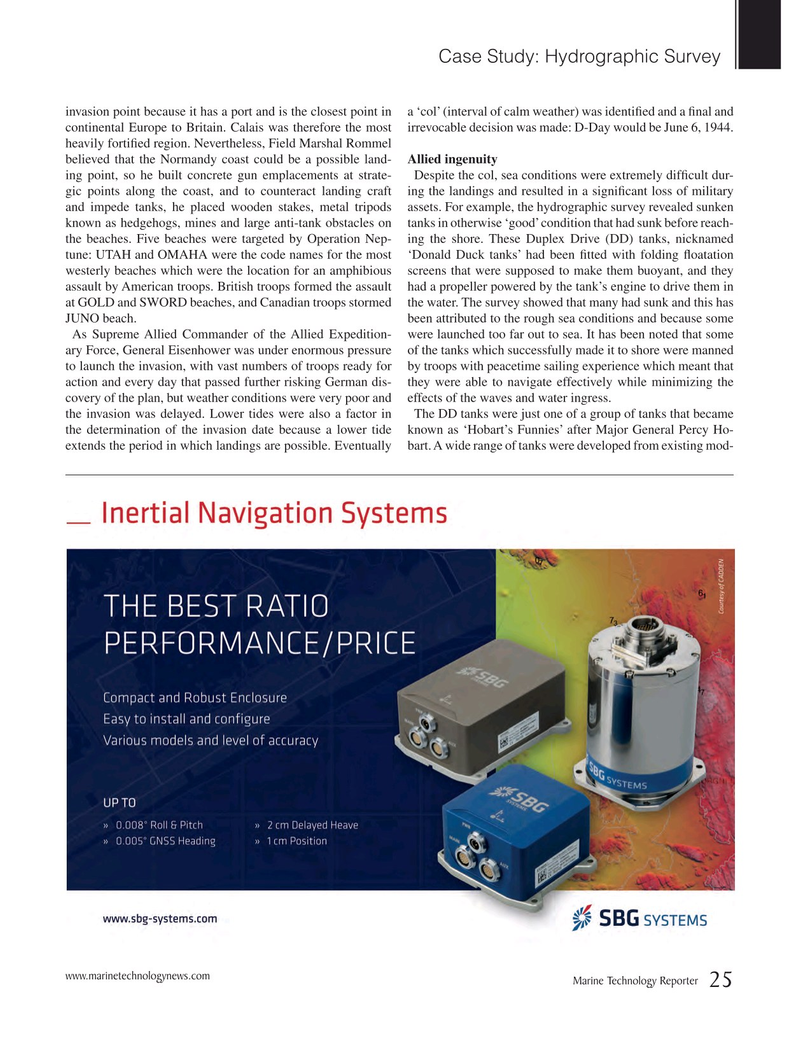
Page 25: of Marine Technology Magazine (November 2016)
Subsea Engineering & Construction
Read this page in Pdf, Flash or Html5 edition of November 2016 Marine Technology Magazine
Case Study: Hydrographic Survey invasion point because it has a port and is the closest point in a ‘col’ (interval of calm weather) was identi? ed and a ? nal and continental Europe to Britain. Calais was therefore the most irrevocable decision was made: D-Day would be June 6, 1944.
heavily forti? ed region. Nevertheless, Field Marshal Rommel believed that the Normandy coast could be a possible land- Allied ingenuity ing point, so he built concrete gun emplacements at strate- Despite the col, sea conditions were extremely dif? cult dur- gic points along the coast, and to counteract landing craft ing the landings and resulted in a signi? cant loss of military and impede tanks, he placed wooden stakes, metal tripods assets. For example, the hydrographic survey revealed sunken known as hedgehogs, mines and large anti-tank obstacles on tanks in otherwise ‘good’ condition that had sunk before reach- the beaches. Five beaches were targeted by Operation Nep- ing the shore. These Duplex Drive (DD) tanks, nicknamed tune: UTAH and OMAHA were the code names for the most ‘Donald Duck tanks’ had been ? tted with folding ? oatation westerly beaches which were the location for an amphibious screens that were supposed to make them buoyant, and they assault by American troops. British troops formed the assault had a propeller powered by the tank’s engine to drive them in at GOLD and SWORD beaches, and Canadian troops stormed the water. The survey showed that many had sunk and this has
JUNO beach. been attributed to the rough sea conditions and because some
As Supreme Allied Commander of the Allied Expedition- were launched too far out to sea. It has been noted that some ary Force, General Eisenhower was under enormous pressure of the tanks which successfully made it to shore were manned to launch the invasion, with vast numbers of troops ready for by troops with peacetime sailing experience which meant that action and every day that passed further risking German dis- they were able to navigate effectively while minimizing the covery of the plan, but weather conditions were very poor and effects of the waves and water ingress. the invasion was delayed. Lower tides were also a factor in The DD tanks were just one of a group of tanks that became the determination of the invasion date because a lower tide known as ‘Hobart’s Funnies’ after Major General Percy Ho- extends the period in which landings are possible. Eventually bart. A wide range of tanks were developed from existing mod- www.marinetechnologynews.com
Marine Technology Reporter 25
MTR #9 (18-33).indd 25 MTR #9 (18-33).indd 25 12/7/2016 2:54:29 PM12/7/2016 2:54:29 PM

 24
24

 26
26
